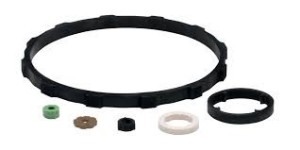Press-in-Place Seals
June 23rd, 2016 by WebSeal Inc
Press-in-Place Seals (PiP) | Drop-in-Place Seals
Press-in-Place (PiP) or "drop-in-place" seals are static seals that overcome installation issues and sealing performance problems common with many typical face seal products, such as an O-ring.
Benefits of Press-in-Place Seals
- Fool-proof installation
- High seal retention
- Cost savings on tooling
- Less micro-leakage
- Easy serviceability and quick removal
A unique seal design, PiP incorporates precision-cut ribs or nibs on the outside or inside diameter of an extruded or molded seal with a rectangular cross-section, which keeps the seal firmly in the seal groove regardless of its functional position and without adhesives. Even if the seal is installed upside down, the press-in-place seal will remain firmly in the groove and maintain high sealing performance.
 Interference created between the groove wall and the nibs on the seal allows for high sealing pressures since the seal retains its cross-section, offering a large contact surface area and improving the seal with non-ideal mating surfaces.
Interference created between the groove wall and the nibs on the seal allows for high sealing pressures since the seal retains its cross-section, offering a large contact surface area and improving the seal with non-ideal mating surfaces.
Since the extruded seals do not use molds, there is a reduction in upfront tooling costs with the added benefit of eliminating voids, flash, and flow or parting lines.
For narrow, straight-walled molded or machined grooves, a cost-effective drop-in-place solution is Parker’s Diamond Seal™. Especially useful as manifold or cover seals, and for use with low to moderate system pressures, this cost-efficient diamond-shaped seal with nibs has a smaller footprint and narrower cross-section, which allows more room for other components. The diamond seal design can also be modified to fit round or other complex groove shapes, depending on the application.
For wider straight-walled or dovetail grooves, Parker’s H-Seal™ resists twisting and provides stability. The small contact points of the nibs on the H-shaped design are particularly advantageous with less-than-perfect mating surfaces as they generate high sealing pressures for reliable performance. The H-seal is particularly effective with perimeter, manifold or cover seals, and performs well in face seals with low to high system pressures. Both the geometry of the H-design and the material compound can be adjusted to meet specific application seal loads.
|
Click Image to Open Full Size in New Tab |
Comments are closed.


 Press-in-Place seal when pressed into groove.
Press-in-Place seal when pressed into groove.